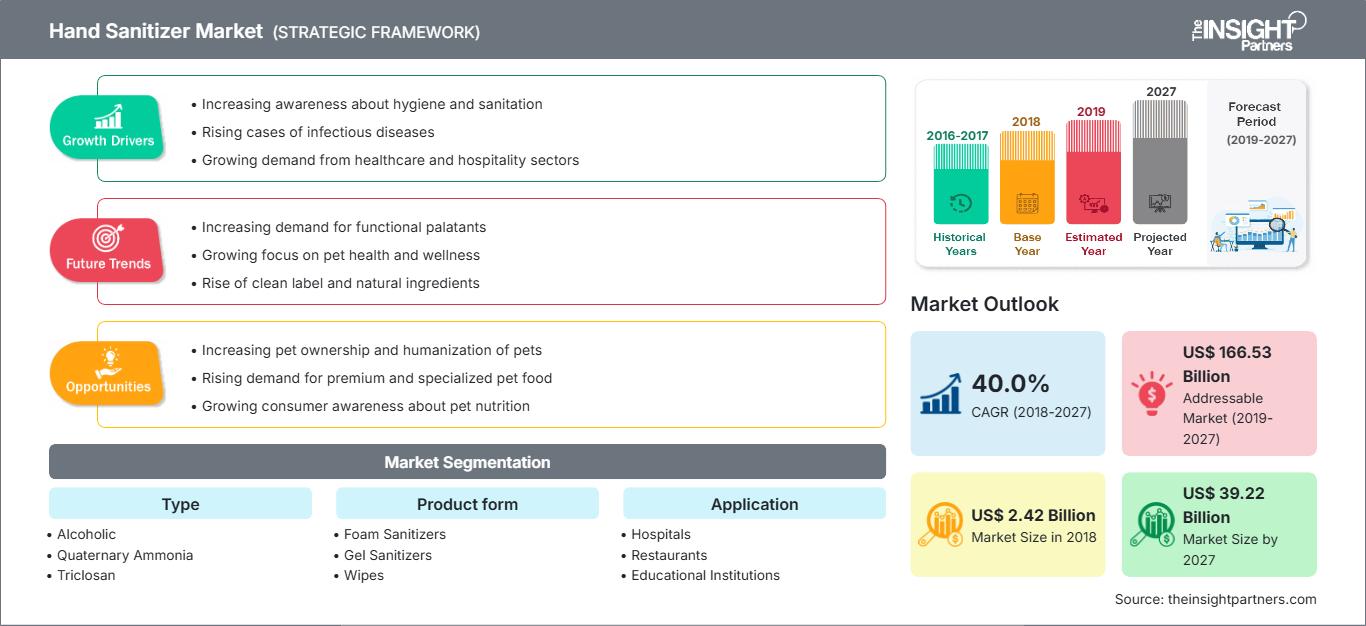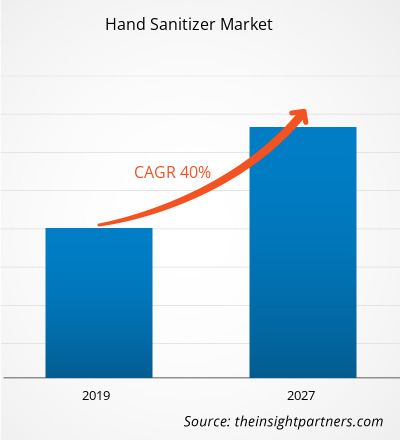El mercado de desinfectante de manos se valoró en US$ 2.421,1 millones en 2018 y se proyecta que valga US$ 39.223,1 millones para 2027, creciendo a una CAGR del 40,0% durante el período de pronóstico.
Los desinfectantes de manos, también conocidos como desinfectantes para manos y antisépticos de manos, se utilizan para neutralizar gérmenes y microbios en la superficie de la piel. Se emplean con frecuencia en entornos laborales y sanitarios cuando el riesgo de transmisión de patógenos infecciosos es mucho mayor. Su eficacia depende de diversos factores, como la cantidad utilizada, la frecuencia de uso y la duración de la exposición. Sin embargo, no sustituyen el lavado de manos exhaustivo. Se cree que ofrecen a los usuarios algunos de los beneficios del lavado de manos cuando no resulta práctico. La creciente concienciación sobre la higiene de manos, el aumento del nivel de vida y la creciente preocupación por el bienestar personal han generado una demanda significativa de desinfectantes de manos. Su uso se ha generalizado en diversos entornos públicos, como gimnasios, restaurantes, hospitales, fábricas, oficinas, centros comerciales, cines, etc. Es probable que su uso generalizado genere importantes oportunidades para la industria de los desinfectantes de manos. Los desinfectantes de manos son fáciles de usar y se pueden llevar a cualquier parte, lo que los hace populares entre los niños en edad escolar. El sector sanitario es un gran consumidor de desinfectantes de manos y genera importantes ingresos para la industria de estos productos. Los frecuentes brotes de gripe y otras enfermedades contagiosas son uno de los factores que explican la creciente demanda de productos desinfectantes de manos.
Personalice este informe según sus necesidades
Obtendrá personalización en cualquier informe, sin cargo, incluidas partes de este informe o análisis a nivel de país, paquete de datos de Excel, así como también grandes ofertas y descuentos para empresas emergentes y universidades.
Mercado de desinfectantes de manos: Perspectivas estratégicas

-
Obtenga las principales tendencias clave del mercado de este informe.Esta muestra GRATUITA incluirá análisis de datos, desde tendencias del mercado hasta estimaciones y pronósticos.
Perspectivas del mercado
Creciente concienciación entre los consumidores sobre el mantenimiento de la salud y la higiene
Los consumidores de la mayoría de los países desarrollados y en desarrollo de América del Norte, Europa y Asia-Pacífico se preocupan mucho por mantener un estilo de vida saludable e higiénico.
Los gérmenes que se propagan por las palmas de las manos entran al cuerpo a través de la boca, la nariz, las heridas en la piel y los ojos. Estos gérmenes causan diversas enfermedades, como infecciones cutáneas y oculares, resfriados, dolor de estómago y muchas otras. Para prevenir estas enfermedades, los desinfectantes de manos son de gran ayuda, eliminando hasta un 99% de gérmenes, bacterias y virus. Están disponibles en formato líquido, aerosol y toallitas, que se utilizan para reducir los agentes infecciosos en las manos. Además del estilo de vida y las enfermedades crónicas, el resfriado, la fiebre y las infecciones son enfermedades de propagación frecuente entre los consumidores; por lo tanto, existe una gran preocupación por prevenirlas. Diversas organizaciones no gubernamentales también trabajan activamente para educar a las personas que viven en zonas remotas sobre cómo mantener la salud y la higiene. Además, las actividades de marketing y promoción de los principales fabricantes de desinfectantes de manos desempeñan un papel importante en la concienciación de los consumidores. Estos factores impulsan el crecimiento del mercado de los desinfectantes de manos.
Información sobre tipos
El mercado global de desinfectantes de manos se clasifica en tres tipos principales: alcohólico, amoníaco cuaternario y triclosán, según los productos químicos utilizados en su preparación. En 2018, el segmento de desinfectantes de manos alcohólicos representó una mayor participación en el mercado global. Sin embargo, se espera que el segmento de amoníaco cuaternario crezca a una tasa de crecimiento anual compuesta (TCAC) más rápida durante el período de pronóstico. Los compuestos de amonio cuaternario son potentes desinfectantes químicos comúnmente utilizados en toallitas desinfectantes, aerosoles y otros limpiadores domésticos que están preparados para eliminar gérmenes. Estos compuestos son bastante efectivos contra bacterias, levaduras, moho y virus. No son corrosivos, no causan irritación de la piel y también son muy estables. Los desinfectantes a base de QUAT son lo suficientemente estables y no pierden su potencia para eliminar gérmenes con el tiempo, sin importar la frecuencia de uso. Debido a la rentabilidad del QUAT, muchos fabricantes lo están utilizando en la elaboración de desinfectantes de manos. Estos factores están influyendo en el crecimiento del mercado de desinfectantes de manos a base de amoníaco cuaternario.
Información sobre el formulario del producto
Según la presentación del producto, el mercado global de desinfectantes de manos se ha segmentado en desinfectantes en espuma, desinfectantes en gel, toallitas y desinfectantes en aerosol. En 2018, el mercado de desinfectantes de manos estuvo liderado por el desinfectante en gel, con la mayor participación de mercado, y se esperaba que mantuviera su dominio durante el período de pronóstico. Sin embargo, se espera que el desinfectante en espuma crezca a una tasa de crecimiento anual compuesta (TCAC) más rápida. Una ventaja real del desinfectante de manos en espuma es que, durante la aplicación, se adhiere a las manos. Este desinfectante en espuma no se desliza fácilmente de las manos como lo hacen los desinfectantes en gel. Los fabricantes ofrecen a los consumidores desinfectantes de manos en espuma, principalmente sin alcohol. Estos desinfectantes eliminan el 99.9% de los gérmenes más comunes y mantienen las manos limpias y suaves. Existe una creciente demanda de estos productos en lugares como guarderías, gimnasios, hospitales, encimeras de cocina, escuelas y oficinas.
Perspectivas de la aplicación
Por aplicación, el mercado global de desinfectantes de manos se ha clasificado en hospitales, restaurantes, instituciones educativas, hogares y otros. El segmento hospitalario lideró el mercado de desinfectantes de manos en 2018 con una mayor participación y se espera que mantenga su dominio durante el período de pronóstico. Los desinfectantes de manos se utilizan ampliamente en todos los hospitales y clínicas del mundo, lo que impulsa este mercado. En los hospitales de todo el mundo, el personal se aplica diligentemente desinfectante de manos para prevenir la propagación de infecciones. Los sistemas de dosificación y dispensadores de desinfectante de manos se utilizan para la desinfección quirúrgica de manos. Los desinfectantes de manos a base de alcohol se recomiendan y utilizan ampliamente en los hospitales. La creciente popularidad de los desinfectantes como medida preventiva se ha identificado como una de las tendencias críticas del mercado de desinfectantes de manos que impulsará el crecimiento del mercado.
Perspectivas de distribución
El mercado global de desinfectantes de manos se segmenta aún más según el canal de distribución, que incluye supermercados e hipermercados, tiendas de conveniencia, tiendas en línea, entre otros. El segmento de hipermercados y supermercados lideró el mercado global de desinfectantes de manos con la mayor participación de mercado y se espera que mantenga su dominio durante el período de pronóstico. Los hipermercados y supermercados son tiendas de autoservicio que ofrecen una amplia variedad de productos desinfectantes de manos, como desinfectantes en espuma, desinfectantes en gel, toallitas y desinfectantes en aerosol. Esta amplia gama de productos se coloca de forma muy organizada en diferentes secciones y estantes para atraer a los clientes. Este tipo de tiendas ofrece a los consumidores una amplia selección de productos de diferentes marcas en un solo lugar y a precios asequibles en comparación con otros canales de distribución. Además, los productos similares se colocan cerca, lo que facilita a los compradores comparar diferentes productos antes de comprar el adecuado. El aumento de la afluencia de clientes a estos lugares, especialmente de compradores preocupados por la salud, junto con la amplia disponibilidad de desinfectantes de manos de diversas marcas a un precio asequible, ha animado a los clientes a comprar desinfectante de manos en hipermercados y supermercados.
Empresas como Henkel AG & Company, KGAA, Reckitt Benckiser Group plc, Ecolab, GOJO Industries, Inc. y otras han implementado diversas estrategias que han impulsado su crecimiento y, a su vez, han impulsado diversos cambios en el mercado. Las fusiones y adquisiciones, así como los lanzamientos de productos, son algunas de las iniciativas que estas empresas han llevado a cabo para ampliar su cuota de mercado. Estrategias como el lanzamiento de productos y las fusiones y adquisiciones les han ayudado a expandir su negocio.
Perspectivas regionales del mercado de desinfectantes de manos
Los analistas de The Insight Partners han explicado detalladamente las tendencias regionales y los factores que influyen en el mercado de desinfectantes de manos durante el período de pronóstico. Esta sección también analiza los segmentos y la geografía del mercado de desinfectantes de manos en América del Norte, Europa, Asia Pacífico, Oriente Medio y África, y América del Sur y Central.
Alcance del informe de mercado de desinfectantes de manos
| Atributo del informe | Detalles |
|---|---|
| Tamaño del mercado en 2018 | US$ 2.42 mil millones |
| Tamaño del mercado en 2027 | US$ 39.22 mil millones |
| CAGR global (2018-2027) | 40.0% |
| Datos históricos | 2016-2017 |
| Período de pronóstico | 2019-2027 |
| Segmentos cubiertos |
Por tipo
|
| Regiones y países cubiertos |
América del norte
|
| Líderes del mercado y perfiles de empresas clave |
|
Densidad de actores del mercado de desinfectantes de manos: comprensión de su impacto en la dinámica empresarial
El mercado de desinfectantes de manos está creciendo rápidamente, impulsado por la creciente demanda del usuario final debido a factores como la evolución de las preferencias de los consumidores, los avances tecnológicos y un mayor conocimiento de los beneficios del producto. A medida que aumenta la demanda, las empresas amplían su oferta, innovan para satisfacer las necesidades de los consumidores y aprovechan las tendencias emergentes, lo que impulsa aún más el crecimiento del mercado.

- Obtenga una descripción general de los principales actores clave del mercado de desinfectantes de manos
Mercado de desinfectantes de manos: por tipo
- Alcohólico
- Amoníaco cuaternario
- Triclosán
Mercado de desinfectantes de manos: por tipo de producto
- Desinfectantes en espuma
- Desinfectantes en gel
- Toallitas
- Desinfectantes en aerosol
Mercado de desinfectantes de manos: por aplicación
- Hospitales
- Restaurantes
- Instituciones educativas
- Familiar
- Otros
Mercado de desinfectantes de manos: por canal de distribución
- Supermercados/Hipermercados
- Tiendas de conveniencia
- En línea
- Otros
Mercado de desinfectantes de manos por geografía
-
América del norte
- A NOSOTROS
- Canadá
- México
-
Europa
- Alemania
- Francia
- Reino Unido
- Rusia
- Resto de Europa
-
Asia-Pacífico
- Australia
- Porcelana
- India
- Japón
- Resto de Asia-Pacífico
-
Oriente Medio y África
- Sudáfrica
- Arabia Saudita
- Emiratos Árabes Unidos
- Resto de Oriente Medio y África
-
Sudamerica
- Brasil
- Argentina
- Resto de Sudamérica
Perfiles de empresas
- Henkel AG & Company, KGAA
- Grupo Reckitt Benckiser plc
- 3M
- Ecolab
- Industrias GOJO Inc.
- Unilever plc
- La compañía farmacéutica Himalaya
- Industrias Godrej Limitada
- Procter & Gamble
- SC Johnson & Son
- Análisis histórico (2 años), año base, pronóstico (7 años) con CAGR
- Análisis PEST y FODA
- Tamaño del mercado, valor/volumen: global, regional y nacional
- Industria y panorama competitivo
- Conjunto de datos de Excel
Informes recientes
Testimonios
Razón para comprar
- Toma de decisiones informada
- Comprensión de la dinámica del mercado
- Análisis competitivo
- Información sobre clientes
- Pronósticos del mercado
- Mitigación de riesgos
- Planificación estratégica
- Justificación de la inversión
- Identificación de mercados emergentes
- Mejora de las estrategias de marketing
- Impulso de la eficiencia operativa
- Alineación con las tendencias regulatorias






















 Obtenga una muestra gratuita para - Mercado de desinfectantes de manos
Obtenga una muestra gratuita para - Mercado de desinfectantes de manos